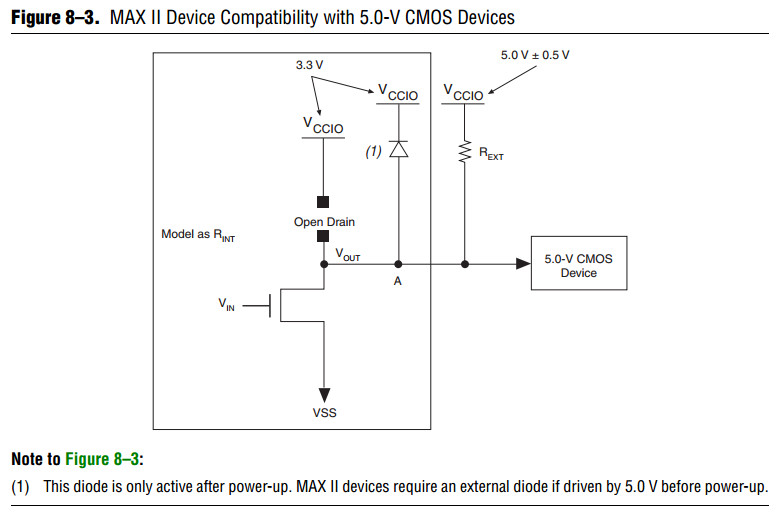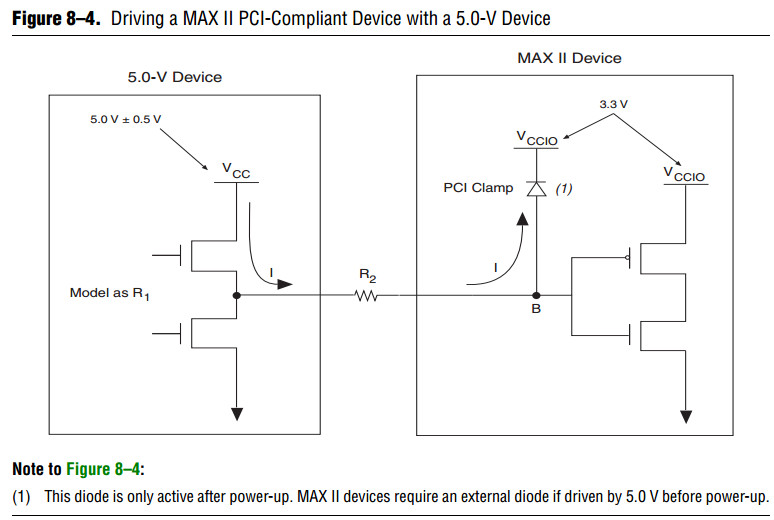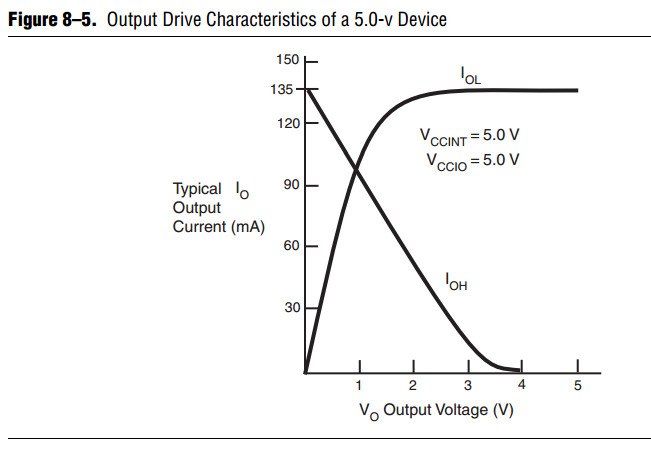MAX II Device Compatibility with 5.0-V CMOS Devices
http://www.altera.com/literature/hb/max2/max2_mii51009.pdf

The open-drain pin never drives high, only low or tri-state. When the open-drain pin is active, it drives low.
When the open-drain pin is inactive, the pin is tri-stated and the trace pulls up to 5.0 V by the external resistor.
The purpose of enabling the I/O clamp diode is to protect the MAX II device’s I/O pins.
The 3.3-V VCCIO supplied to the I/O clamp diodes causes the voltage at point A to clamp at 4.0 V,
which meets the MAX II device’s reliability limits when the trace voltage exceeds 4.0 V.
The device operates successfully because a 5.0-V input is within its input specification.
The I/O clamp diode is only supported in the EPM1270 and EPM2210 devices’ I/O Bank 3.
An external protection diode is needed for other I/O banks in EPM1270 and EPM2210 devices
and all I/O pins in EPM240 and EPM570 devices.
The pull-up resistor value should be small enough for sufficient signal rise time,
but large enough so that it does not violate the IOL (output low) specification of MAX II devices.
The maximum MAX II device IOL depends on the programmable drive strength of the I/O output.
Table 8–1 shows the programmable drive strength settings
that are available for the 3.3-V LVTTL/LVCMOS I/O standard for MAX II devices.
The Quartus II software uses the maximum current strength as the default setting.
The PCI I/O standard is always set at 20 mA with no alternate setting.

To compute the required value of REXT, first calculate the model of the open-drain
transistors on the MAX II device. This output resistor (REXT) can be modeled by
dividing VOL by IOL (REXT = VOL/IOL). Table 8–2 shows the maximum VOL for the 3.3-V
LVTTL/LVCMOS I/O standard for MAX II devices.
f For more information about I/O standard specifications, refer to the DC and Switching
Characteristics chapter in the MAX II Device Handbook.

Select REXT so that the MAX II device’s IOL specification is not violated. You can
compute the required pull-up resistor value of REXT by using the equation: REXT =
(VCC/IOL) – RINT. For example, if an I/O pin is configured as a 3.3-V LVTTL with a 16
mA drive strength, given that the maximum power supply (VCC) is 5.5 V, the value of
REXT can be calculated as follows:

This resistor value computation assumes worst-case conditions. You can adjust the
REXT value according to the device configuration drive strength. Additionally, if your
system does not see a wide variation in voltage-supply levels, you can adjust these
calculations accordingly.

Because MAX II devices are 3.3-V, 32-bit, 66-MHz PCI compliant, the input circuitry
accepts a maximum high-level input voltage (VIH) of 4.0 V.
To drive a MAX II device with a 5.0-V device, you must connect a resistor (R2)
between the MAX II device and the 5.0-V device. See Figure 8–4.
If VCCIO for MAX II devices is 3.3 V and the I/O clamp diode is enabled, the voltage at point B in Figure 8–4 is 4.0 V,
which meets the MAX II devices reliability limits when the trace voltage exceeds 4.0 V.
To limit large current draw from the 5.0-V device, R2 should be small enough for a fast signal rise time
and large enough so that it does not violate the high-level output current (IOH) specifications of the devices driving the trace.
To compute the required value of R2, first calculate the model of the pull-up transistors on the 5.0-V device.
This output resistor (R1) can be modeled by dividing the 5.0-V device supply voltage (VCC) by the IOH: R1 = VCC/IOH
Figure 8–5 shows an example of typical output drive characteristics of a 5.0-V device.

As shown above, R1 = 5.0 V/135 mA.
The values usually shown in data sheets reflect typical operating conditions.
Subtract 20% from the data sheet value for guard band.
This subtraction applied to the above example gives R1 a value of 30.
Select R2 so that the MAX II device’s IOH specification is not violated. For example,
if the above device has a maximum IOH of 8 mA, given the I/O clamp diode,
VIN = VCCIO + 0.7 V = 3.7 V.
Given that the maximum supply load of a 5.0-V device (VCC) is 5.5 V, the value of R2
can be calculated as follows:

This analysis assumes worst-case conditions. If your system does not see a wide
variation in voltage-supply levels, you can adjust these calculations accordingly.
Because 5.0-V device tolerance in MAX II devices requires use of the I/O clamp, and
this clamp is activated only after power-up, 5.0-V signals may not be driven into the
device until it is configured.
The I/O clamp diode is only supported in the EPM1270 and EPM2210 devices’ I/O Bank 3.
An external protection diode is needed for other I/O banks for EPM1270 and EPM2210 devices
and all I/O pins in EPM240 and EPM570 devices.
MAX II Device Compatibility with 5.0-V CMOS Devices的更多相关文章
- Multiplexing SDIO Devices Using MAX II or CoolRunner-II CPLD
XAPP906 Supporting Multiple SD Devices with CoolRunner-II CPLDs There has been an increasing demand ...
- Delphi XE5 Device compatibility
Delphi XE5 Device compatibility https://docs.google.com/spreadsheet/ccc?key=0AoEN2CEsVvJ0dGhVaWJE ...
- 3、一、Introduction(入门):2、Device Compatibility(设备兼容性)
2.Device Compatibility(设备兼容性) Android is designed to run on many different types of devices, from ...
- java.lang.UnsatisfiedLinkError: org.apache.hadoop.util.NativeCrc32.nativeComputeChunkedSumsByteArray(II[BI[BIILjava/lang/String;JZ)V
环境: Spark2.1.0 .Hadoop-2.7.5 代码运行系统:Win 7在运行Spark程序写出文件(savaAsTextFile)的时候,我遇到了这个错误: // :: ERROR U ...
- Android Google官方文档解析之——Device Compatibility
Android is designed to run on many different types of devices, from phones to tablets and television ...
- win7上代码连接hadoop出现错误 :org.apache.hadoop.util.NativeCrc32.nativeComputeChunkedSumsByteArray(II[BI[BIILjava/lang/String;JZ)V
在idea和eclipse中调试hadoop中hdfs文件,之前好好的,结果突然就出现java.lang.UnsatisfiedLinkError: org.apache.hadoop.util.Na ...
- 关于freemarker标签+Spring3.0 V层学习
import标签 就是把其他的ftl页面引用进来 <#import "/common/ui.ftl" as ui> 使用时 <@ui.message/>,m ...
- linux内核挂载根文件系统时报错”VFS: Cannot open root device "ram0" or unknown-block(0,0): error -6“如何处理?
1. 通过error -6得到: #define ENXIO 6 /* No such device or address */ 2. 解决办法 使能CONFIG_BL ...
- VFS: Cannot open root device "nfs" or unknown-block(0,255)错误的解决
1. 解决办法:在内核配置时候文件系统中选中Root file system on NFS
随机推荐
- html-示例代码
<!DOCTYPE html> <html lang="en" xmlns="http://www.w3.org/1999/html" xml ...
- html- 头部元素
一:HTML <head> 元素 <head> 元素是所有头部元素的容器.<head> 内的元素可包含脚本,指示浏览器在何处可以找到样式表,提供元信息,等等. 以下 ...
- 【Android开发日记】之入门篇(八)——Android数据存储(下)
废话不多说了,紧接着来讲数据库的操作吧.Come On! 提到数据存储问题,数据库是不得不提的.数据库是用来存储关系型数据的不二利器.Android为开发者提供了强大的数据库支持,可以用来轻松地构造基 ...
- win10 操作配置备忘
让程序自动启动 如果想要实现应用程序在所有的用户登录系统后都能自动启动,就把该应用程序的快捷方式放到"系统启动文件夹"里: C:\ProgramData\Microsoft\Win ...
- Codeforces 332B Maximum Absurdity(DP+前缀和处理)
题目链接:http://codeforces.com/problemset/problem/332/B 题目大意:给你n个数和一个整数k,要求找到不相交的两个长度为k的区间,使得区间和最大,输出这两个 ...
- 20155309 《java程序设计》实验四Android程序设计
任务一: 完成Hello World, 要求修改res目录中的内容,Hello World后要显示自己的学号 完成这个任务,首先需要了解Android应用程序文件的组成: src目录: 在src目录中 ...
- 【PAT】1017 A除以B(20 分)
1017 A除以B(20 分) 本题要求计算 A/B,其中 A 是不超过 1000 位的正整数,B 是 1 位正整数.你需要输出商数 Q 和余数 R,使得 A=B×Q+R 成立. 输入格式: 输入在一 ...
- day7 面向对象进阶
面向对象高级语法部分 通过@staticmethod装饰器即可把其装饰的方法变为一个静态方法,什么是静态方法呢?其实不难理解,普通的方法,可以在实例化后直接调用,并且在方法里可以通过self.调用实例 ...
- 【POJ】4007.Flood-it!
原题戳这里 题解 搜索是个好东西,不是人人都会搜 迭代加深,然后用一个函数估值,值是除了和左上连通的部分还有几个颜色不同的块,如果走的步数加上估值大于当前枚举的深度就跳出 代码 #include &l ...
- USACO 5.1 Musical Themes(哈希+二分)
Musical ThemesBrian Dean A musical melody is represented as a sequence of N (1 <= N <= 5000) n ...
